Though it’s gotten better over time, boatbuilding remains a messy business. Fiberglass resin stinks, it itches, and the assembly line can be one hot, sweaty, monotonous environment. Why do it? For some, the answer is a paycheck. For countless others, however, a much deeper satisfaction is derived.
We recently met some of the latter people at Cobalt Boats and Regal Marine, but you find them at builders throughout the industry. For them, boatbuilding is not just a job, it’s a passion — a craft they take immense pride in and insist on not just doing, but doing right. These are the people who agonize over a boat’s form, obsess on its function and then painstakingly put it all together, piece by well-crafted piece. If something’s not right, they fix it. And when they discover how to do it better, they do so.
Sure, these folks could build a boat faster, cheaper and easier. Instead, they elect to do it right, just like generations of the best builders have done before them.
Indeed, boatbuilding remains one of America’s few manufacturing industries that hasn’t been outsourced. It’s time to meet some of the people between you and your next boat — and discover why they matter.
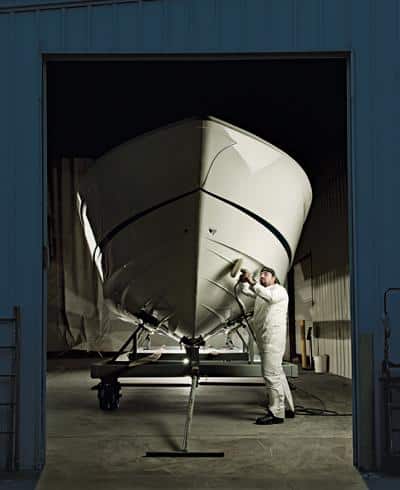
At the Drawing Board
Long before a boat is ever fabricated in fiberglass, a company has to choose what it will look like. For Cobalt, that responsibility has often fallen to iconic boat designer peter Granata. It’s Granata’s job to decipher not just what a client has in mind for the design, but ultimately what he or she is trying to accomplish with the product as well.
Visual appeal can’t be underestimated. “You have to remember,” Granata tells clients, that “even with the best engineered cars in the world, if they don’t look good, they don’t sell.” That’s why attention is paid not only to a boat’s overall style, but also to elements that attract a customer’s immediate attention — dash, steering wheel and the size and comfort of the seats.
If the job has been done right, little details will show through, and Granata says it’s critical to design a boat with the customer in mind. “A lot of boat companies will do research on who their consumer is,” he explains. “That’s a false read. What they need to do is go out and find out who their consumer aspires to be.”
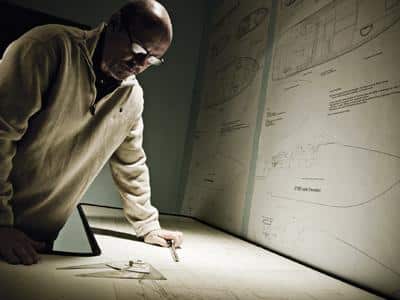
Of course, there have to be checks and balances along the way. Guys like Regal’s vice president of engineering, Pat Wiesner, are among them. At Regal, new product planning committees blend designers with engineers and manufacturers (especially company president Duane Kuck) to guarantee a project is not only eye-catching but also viable. Regal works extensively with 3-D modeling software, fabricating a virtual product from hull and stringers all the way to cabinetry, not only to validate the product but also to reduce work down the line. “We try and take that model to the nth degree,” Wiesner explains. “The more time we put into it on the computer, the better it’s going to be.”
Computers deliver precise shapes and sizes, but they can’t gauge the psychological and ergonomic impact of key features. That’s why certain components — a helm or a doorway — are mocked up full size for evaluation. Once everything receives the final OK, a plug is cut, a mold is made, and ultimately a single boat is built. Countless tests are then completed, from performance to ride to endurance, to make sure the model meets expectations. Regal employs naval architects during the design process. Then they come back to validate the end result.
The job never stops. Borrowing a lesson from Harvard Business School, the entire project is re-evaluated. Sums up Wiesner: “Every time we do a new boat we review what happened, what was expected … and how to make it better the next time.”
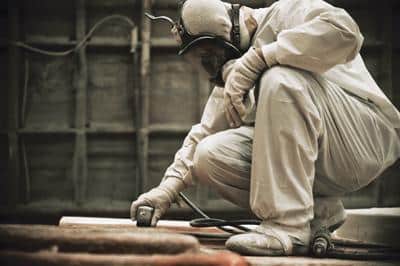
Old-Fashioned American Muscle
Still, a concept truly becomes reality for a consumer only on the assembly line, where blue-collar workers lay up hulls, fabricate countless smaller components and then literally start to assemble the puzzle, piece by piece, in full-scale production.
Quality builders not only closely monitor the process but also constantly try to improve upon it. Regal’s technicians are routinely exposed to new methodologies to make their efforts more productive.
“We’re constantly coaching and educating them on lean manufacturing, and what we need to do as a company in the long term,” explains Andre Rakofsky, Regal’s senior team leader for yacht assembly. “When they understand that, when they play a role, they feel good about what they’re doing.”
Regal enforces the same workmanship standards for a 22-foot runabout as it does for a 50-foot yacht. A worker with significant tenure often applies those standards; many count 20-plus years with the company. “It’s easy to tell somebody they’ve got to work faster,” Rakofsky says. “But when you actually show them a way to do it better, why we need to try to do it that way, and then they buy into it, the effects just multiply.”
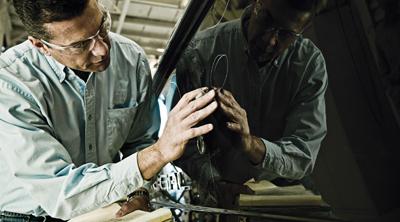
Motivating employees is a trait shared by Cobalt. Here, a monthly bonus program appeals not only to a worker’s pride but also his wallet. It’s based on profit, a bottom line that’s reduced by warranty claims. “If a boat is the best quality it can be when it leaves, it’s probably not going to come back on a warranty claim,” explains Tony Altis, supervisor of small-boat assembly. “That means that’s more money in our pocket.”
Altis says that Cobalt workers aren’t pressured to produce. Instead, they’re told the company’s primary expectation is that they simply do their best with what they’re handed that day. Cobalt employees also take natural pride in the brand’s reputation. Though the company has a dedicated quality control department, builders are told they too are an integral part of the process. “Just about everybody who touches the boat can tell you if it’s up to quality or not,” Altis explains.
Maintaining that reputation is hard work, but worth it. “It may be twice as hard as some other companies,” Altis says, “but when I go home at night I know that we’re still the best at what we’re doing.
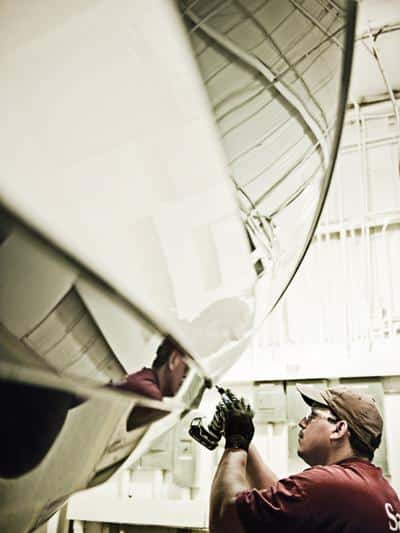
Close Attention to Detail
It would be easy to say that the last line drawn in the sand is quality control, but in reality, good builders employ quality control techniques at every step of the boatbuilding process.
Regal’s David Burroughs says it starts when a boat is still “in the barrel.” Checks are made of materials and consistency, followed by audits of weight and gelcoat thickness once hulls and decks are released from the mold. Random checks follow throughout the assembly process. At every step of the build, a paper trail follows the boat. Regal even employs an in-house lab to test both its own and third-party parts.
However, Burroughs is not afraid to take the ultimate responsibility. “I’m not the only guy in quality in this building,” he says. “I’m just the enforcer.”
Burroughs notes that frequent quality checks allow problems to be caught early, while they’re still small. Still, some issues often aren’t apparent until the inspector can view the boat on a grander scale. That’s why Burroughs always views the boats as they exit the factory doors, and immediately sends back any potential problems. Any mistake, from a stripped screw head to upholstery stripes that don’t match from cushion to cushion, are flagged for repair.
Once a week, quality control teams meet with engineering and customer service to go over warranty claims. Even a onetime complaint is put on their radar screen. “To me it’s a very personal job,” Burroughs says. “I try to make it as perfect as I can for the customer.”
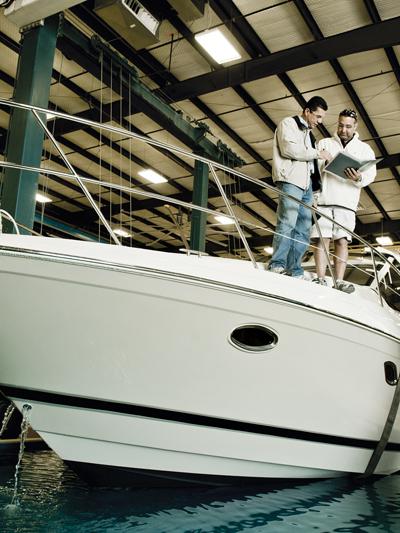
Part of the quest for perfection includes putting boats in the water. Both Regal and Cobalt water-test every larger model. Regal also water-tests one in five runabouts; Cobalt puts smaller boats in a test tank. First-year products get an even more thorough once-over, as techs try to dial in which prop to use and proper gear ratios to achieve optimum speed and acceleration and minimum bow rise.
“Everything is pretested and recorded,” says Cobalt product technician Rick Shadduck, who estimates he’s water-tested one boat a day since 1989. “It’s kind of like a pre-break-in period. We make sure everything is all right on the boat, make sure things are hooked up right, that it shifts right, steers well, and that there are no fluid, water or fuel leaks.”
End Game: Waterborne Delivery
The person who gets the thrill of handing a new owner the keys, however, is typically the delivery captain. Certainly a fun job, but still, one with a unique set of responsibilities.
“I’m the final Q&A guy,” says Thomas Straigis, delivery captain for Cobalt dealer Arrowhead Boat Sales. “Throwing the keys to the customer and saying, ‘Enjoy. There’s the pointy end; there’s the noisy end,’ it just doesn’t work with boats nowadays.” Instead, Straigis goes over a boat 48 hours before delivery and re-examines it after cleaning crews have been aboard. He sometimes finds little things, but as a certified MerCruiser technician, he’s also ready for more serious issues.
Straigis also makes sure the boat is loaded with everything the customer will need. Extra engine oil is a must, not only to show the customer the type he should be using but also because levels are likely to get low during the break-in period.
“We have customers that say, ‘Well, here’s the first-happiest day of owning a boat’ (implying the second is the day that it’s sold). I try to explain to them that’s not so when you buy a good quality boat.”
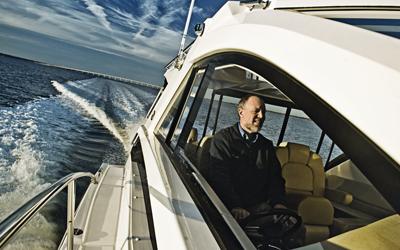
Regal delivery captain Frank Stoeber shares that pride. He often sits anywhere a customer is likely to spend significant time, noting anything that’s not perfect. “That’s kind of like a sand spur in their underpants,” says Stoeber of any problem he notes. “Any time they sit there, they’re going to see it.”
Stoeber starts a delivery days before, with a call to the customers, gauging their knowledge and tailoring his approach to what they need. He is conscious of getting a customer written materials before the delivery, noting that “a great delivery starts with preparation. It’s critical.”
When the time comes for actual hands-on instruction, he tries his best to keep his hands in his pockets. “Adults learn by doing. I try to give the knowledge so they can develop the skill.” After a delivery, the job continues. Stoeber constantly reviews every detail and fine-tunes the process to make it better.
Says Stoeber: “How that delivery goes is going to set their paradigm of that boat…maybe for a lifetime.
Final Check: Riggers
For all the quality control efforts put forth by a manufacturer, the final person responsible for that all-important first impression is a dealership’s rigger. David Bourgeois handles the job for Texas Cobalt dealer The Slalom Shop.
What They Do: Riggers not only remove the factory shrink-wrap, install batteries and drain plugs, add fuel and check to make sure shift and throttle cables are properly adjusted, but they also sea-trial the boat to ensure it performs as promised.
Who’s Responsible: Even the best manufacturers can’t catch everything. Steering wheel crooked at speed? A test-tank run might not have caught it, but you can bet a good rigger will during his test run.
Why They Matter: A boat may leave the factory in perfect condition, but a lot can happen on the road, even in the showroom. The rigger is the one who warranties any items that have broken or weren’t assembled properly. “When you spend this much on a boat,” Bourgeois says, “the last thing you want a customer thinking is ‘Somebody should have caught this.'”
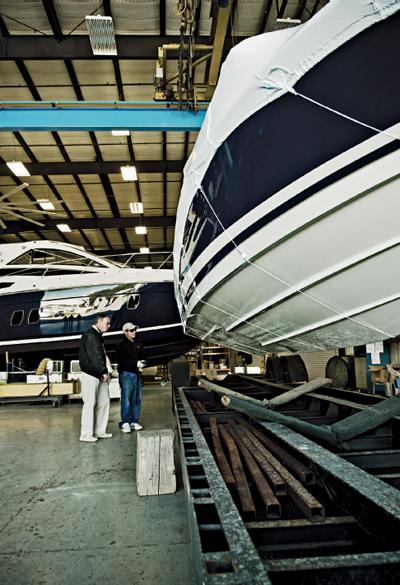
Transporters By Land
While a boat may be meticulously crafted at the factory, and salivated over at a dealership, the chain of custody between the two locations is interrupted but once — in transport. That’s when companies like Carthage Marine Transport earn their pay, regularly hauling millions of dollars in cargo across the country.
What They Do: Truckers don’t just haul boats; they also play a key role in the loading of a vessel. Carthage patriarch Brooks Gubser says that preparing a boat for a long haul is much like building an erector set. The driver and loading dock personnel rely on plenty of steel, rigging, straps and ratchets to keep everything secure, eliminate pressure spots and avoid damage.
Who’s Responsible: Once on the road, the carrier assumes all responsibility, their contents covered under the terms of their cargo insurance. Good ones perform frequent checks of their cargo, stop in only secure truck stops and sleep in their rigs to avoid leaving boats unattended.
Why They Matter: Outside of the obvious, truckers act as unofficial ambassadors for the boat companies. Gubser says, “People definitely notice the boats…and are eager to talk about them.”









